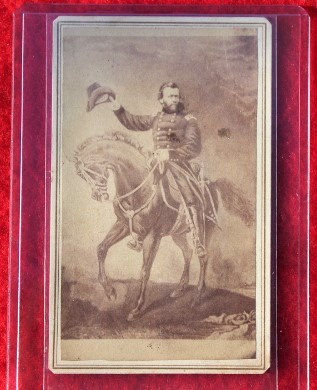Calling Cards of General U. S. Grant and His Wife Julia
Item #: AA3078
This is a set of calling cards of General Ulysses Simpson Grant and his wife Julia from the Civil War era. The set of calling cards also comes with a Carte De Vista of General Grant mounted on horse back. Calling cards were very popular in the 19th century, as they served as an important means of communication with the socially elite. These cards served to announce that a visit had been made to someone's home or place of business by the person leaving the card. Normally a calling card would arrive at the originators home within a couple of days, often with a brief message on the back of the card to arrange a visit. There were certain protocols to be observed when leaving a calling card. For example, if you arrived home to find a calling card at your residence and the upper right hand corner of the card was folded over, that indicated that the person leaving the card had done so in person. Calling cards in sealed envelopes represented the same message, that the person leaving the card had attempted to deliver it in person. If no acknowledgement of the card was made, or if the sealed envelope was returned that meant the party requested had rejected the invitation for a social visit. Folding of different corners meant different things. For example, the folded lower left hand corner was meant to express condolences. A folded upper left hand corner was used to convey congratulations, and a folded lower right hand corner showed that the caller was leaving on a long trip and did not expect an acknowledgement of the card. Homes of the socially elite often had silver trays in the entrance foyers or halls so visitors could leave their cards. The most prominent visitors had their cards displayed on top, to show the homes social connections. Both men and women used calling cards, and each gender had separate rules to observe when using them. Newspapers even printed articles on calling card etiquette. Men's cards were generally were long and narrow so they could be carried in a breast pocket. Women's calling cards tended to be a bit larger, and during the Victorian era were very ornate and embellished. By the beginning of the 1900's began to decline in popularity. General Grant's calling card measures approximately 3 1/2' wide and 1 3/4" tall. It is made of simple white card stock and has Gen. U.S. Grant. in old English script letters on the front. The back of the card is blank. Julia Grant's card measures approximately 3 3/4" wide and 2 1/4" tall. It is also made of simple card stock, with small old English lettering that reads Mrs. U. S. Grant. The back of this card is also blank. The CDV of Grant is a studio portrait of him mounted on horseback. He wears the uniform of a Lieutenant General, mounted on a black horse with the reins in his left hand and his hat in his right hand. The three stars of a Lieutenant General can be seen on the saddle blanket. There is no back mark, and the card is an artist's drawing instead of an actual image of Grant. These CDV's were also used as calling cards. The back of this CDV is blank. This is a very scarce set of Grant calling cards, and to find U.S. and Julia Grant's cards together in one set is pretty near impossible to do. All three come ready for display in a riker case.
Shipping Weight:
3 lbs
Item # AA3078
Your Price $1,650.00 USD
We are currently not accepting on-line orders. If you see something you would like give us a call.












